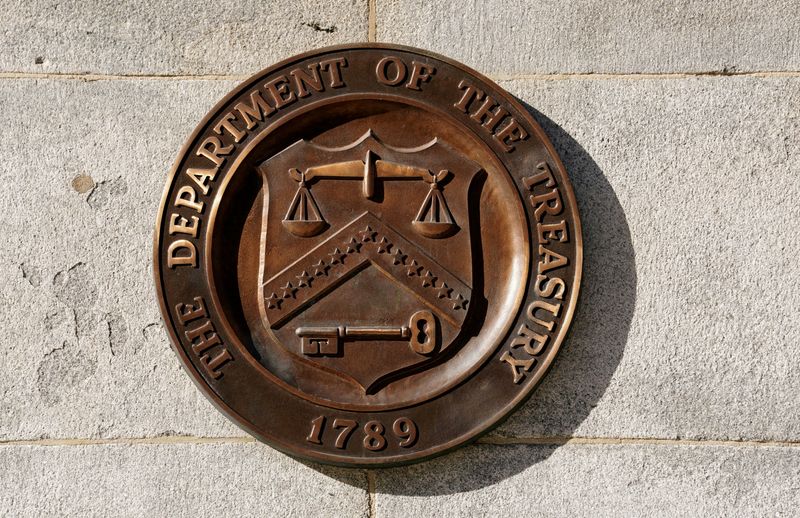By Gertrude Chavez-Dreyfuss
NEW YORK (Reuters) - An early end or a slowdown in the pace of the Federal Reserve's ongoing balance sheet reduction would cut the supply of U.S. government debt, a move expected by some large banks to boost or widen swap spreads, which typically reflect supply and demand risks tied to Treasuries.
A swap spread is expressed as the basis-point difference between the fixed rate of an interest-rate swap tied to the Secured Overnight Financing Rate (SOFR) and the Treasury yield of the same maturity.
That spread also takes into account the cost of financing a long or short position in Treasuries.
In general, a wider spread means the cost of funding Treasuries is lower compared to swaps.
Rate swaps measure the cost of exchanging fixed-rate cash flows for floating-rate ones, or vice versa. Investors and corporations tap the more than $600 trillion market to hedge interest rate risk, or bet on where Federal Reserve policy rates are headed.
Swaps spreads have come into the spotlight this year after recent comments from U.S. central bank officials suggesting the Fed's process of reducing its balance sheet, also known as quantitative tightening (QT), may be winding down soon.
Fed officials were concerned about the rapid drawdown of funds in the central bank's overnight reverse repo facility (RRP), which acts to absorb the market's excess liquidity. Lower usage of RRP suggests liquidity is becoming scarce.
Banks such as Goldman Sachs and TD Securities said the Fed could start slowing QT possibly before summer, which would be earlier than markets had been expecting.
Since mid-2022, the Fed has been allowing up to $60 billion of Treasuries to mature from its balance sheet each month. The balance sheet ballooned to about $9 trillion as the Fed bought Treasuries and other fixed income securities to keep rates down during the pandemic.
But since the Fed is no longer buying U.S. Treasuries, QT effectively increases government borrowing needs by $720 billion annually.
An early exit from QT would mean the Treasury's financing needs would decline because it no longer needs to borrow as much to cover the Fed's redemptions. This would reduce the issuance of U.S. debt and remove a supply-related premium to yields that lowers the cost of funding Treasuries relative to swaps.
"The main story this year has been expectations for a taper in QT getting pulled forward," said Daniel Krieter, director, fixed income strategy at BMO Capital in Chicago. "The whole (swap spread) curve has widened since January as result, but the short end has widened more than the long end."
The spread on two-year U.S. swaps over two-year Treasuries was at -14 basis points (bps) on Wednesday, pulling away from the -23 bps hit in late December its tightest, or most negative level on record.
Shorter-term spreads used to be positive though. With the recent transition to risk-free SOFR from Libor, there is no longer a premium for credit risk embedded in swap rates that pushed them higher in the past.
Analysts also said negative swap spreads reflect investor perception that U.S. sovereign risk has deteriorated and Treasuries are no longer viewed as as risk-free.
IF NO EARLY TAPER, WHAT THEN?
Of course, the Fed could continue to run down its balance sheet until the fourth quarter, in line with what primary dealer banks expected in a poll taken in December.
In this case, swap spreads could narrow slightly, or turn more negative, unwinding some of the widening that happened last month, analysts said.
Even with the taper, though, U.S. long-term swap spreads are expected to tighten further, analysts said, due to rising net issuance of Treasury debt amid wider budget deficits. Increased supply of Treasuries puts pressure on the swaps curve because investors will demand a premium in buying the government's debt.
While the Treasury announced last week that it does not expect further increases in auction sizes beyond April for the next several quarters given lower projected borrowing needs, Treasury's net issuance is expected to rise nonetheless to $1.6 trillion this year, from $1 trillion in 2023, according to Barclays.

"We're running large deficits and we have issued a ton of debt every year and someone has to buy that," said Praveen Korapaty, chief interest rates strategist at Goldman Sachs in New York. "So people buying long maturities need financing and need to reflect the increased cost of financing that debt."
The spread on U.S. 30-year swaps over 30-year Treasuries was -73 bps on Wednesday. It has been in the -68 to -73 bps range since the beginning of the year. The 30-year spread turned negative for the first time in October 2008 in the midst of the global financial crisis.